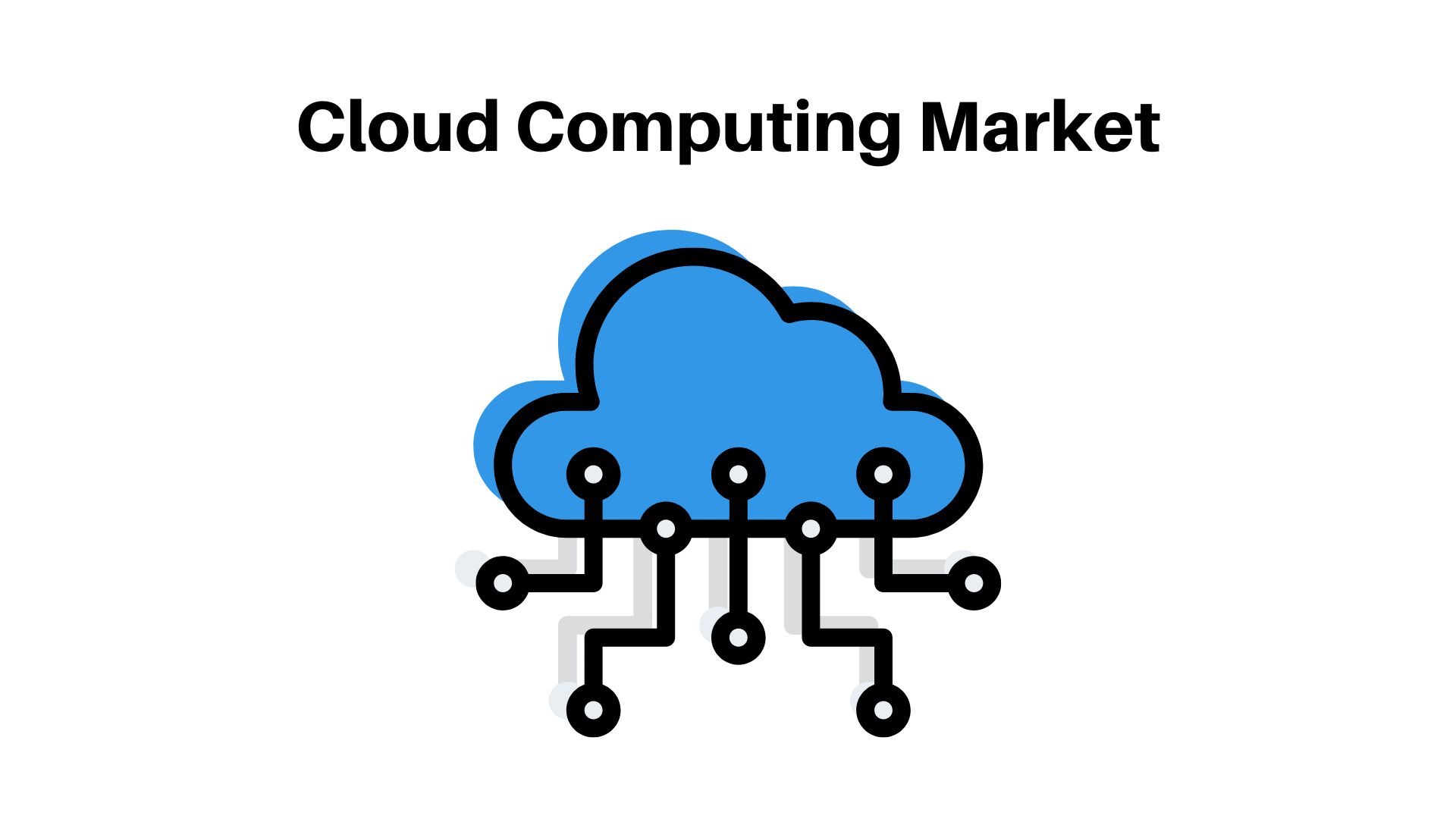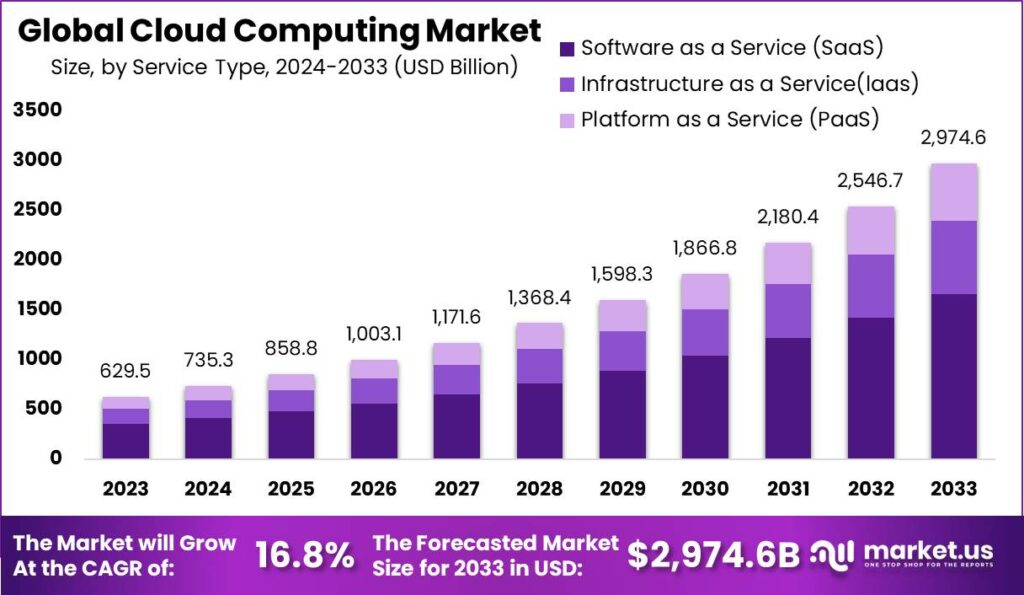Cloud Computing Market Size Will Hit US$ 2974 billion by 2033

Page Contents
Published Via 11Press: The Cloud Computing Market has demonstrated significant growth, with its valuation in 2023 reaching US$ 629.5 billion. Looking ahead, the market is projected to experience a robust expansion, with forecast revenue expected to ascend to US$ 2,974.6 billion by 2033. This projection is supported by a Compound Annual Growth Rate (CAGR) of 16.8% during the period from 2024 to 2033. Such growth can be attributed to the increasing adoption of cloud services across various industries, driven by the need for scalable infrastructure, cost efficiency, and enhanced operational flexibility. This trend underscores the market's vital role in the digital transformation strategies of businesses worldwide.
Organizations are seeking solutions that allow them to reduce capital expenditure while still providing the necessary infrastructure for their business operations. Cloud-based services provide these advantages, allowing companies to pay only for what they need when they need it without having to invest heavily upfront. Additionally, cloud-based services can offer enhanced security and automation capabilities which can help organizations improve efficiency and performance. This article will provide an introduction to the cloud computing market, covering its drivers, trends, and challenges.
Key Takeaways
- The Cloud Computing Market is projected to grow to approximately USD 2,974.6 Billion by 2033, showing a robust compound annual growth rate (CAGR) of 16.8%.
- In 2023, the market was valued at USD 629.5 Billion, indicating significant growth potential over the forecast period.
Cloud computing services encompass various types, including Software as a Service (SaaS), Infrastructure as a Service (IaaS), and Platform as a Service (PaaS). - Among these service types, Software as a Service (SaaS) held the largest revenue share of 55.8% in 2023.
Deployment modes in the market include Hybrid Cloud, Private Cloud, and Public Cloud, with the private cloud segment leading with a revenue share of 43.1% in 2023. - Large enterprises accounted for the majority of revenue share, holding 59.0% in 2023.
- The Banking, Financial Services, and Insurance (BFSI) sector dominated the market with a revenue share of 21.5% in 2023.
- North America led the global market with a revenue share of 39.3% in 2023, driven by advanced technological infrastructure and early adoption of cloud services.
- The increasing adoption of hybrid cloud solutions is a notable trend in the market, offering a balanced approach between public and private clouds.
- Major players in the market include Amazon Web Services (AWS), Microsoft Azure, Google Cloud Platform, IBM Cloud, and Oracle Cloud, among others.
- Geopolitical tensions and policy shifts can significantly impact the market, influencing market entry strategies and operational models.
- Concerns regarding data security and privacy remain a primary restraining factor for market growth, particularly in industries handling sensitive data.
- Integration with advanced technologies like artificial intelligence (AI), machine learning (ML), and the internet of things (IoT) presents a significant growth opportunity for the market.

Get a comprehensive report summary that describes the market value and forecast along with methodology.
Download the PDF brochure: https://market.us/report/cloud-computing-market/request-sample/
The growth of the Cloud Computing Market is driven by a multitude of factors, reflecting the increasing reliance of businesses across various sectors on cloud technologies to enhance operational efficiency, agility, and innovation. A significant driver is the rising adoption of cloud-native applications, which enable businesses to develop, manage, and deploy web applications swiftly and efficiently across sectors such as banking and supply chain automation. This adoption is facilitated by collaborations between technology providers and cloud services, aimed at extending cloud capabilities to new markets and improving existing ones.
Rapid digitization is compelling organizations to modernize their IT and application infrastructure, thereby driving cost efficiency and business agility. By moving workloads to cloud platforms, organizations can circumvent network latency, support critical business functions, and leverage the rapid deployment of cloud solutions and services. The emphasis on data security and privacy remains paramount, with cloud providers offering robust security measures like data encryption and access control to protect sensitive information.
Additionally, the cloud computing landscape is influenced by broader digital transformation trends and the pressing need for businesses to adapt to changing work environments, such as hybrid work models. The flexibility and scalability provided by cloud services reduce the financial risks associated with innovation, especially in uncertain economic times. Key trends for 2023 include leveraging the cloud for hybrid working arrangements, achieving sustainability goals through more efficient cloud infrastructure, and the essential adoption of AI and machine learning technologies that cloud platforms facilitate. The expansion of ‘Everything-as-a-Service' (XaaS) models also plays a critical role, offering businesses unprecedented flexibility and cost efficiency.
Benefits
- Preventing Data Loss: Cloud computing secures data offsite with backups and real-time updates, mitigating risks associated with local hardware issues like fire, theft, or failure.
- Sustainability: Opting for cloud computing contributes to environmental sustainability by leveraging green energy sources, with leading providers like Amazon, Google, and Microsoft investing in renewable energy to power their services.
- Reliable Support: Cloud providers offer extensive technical documentation and community support for troubleshooting, alongside a variety of support plans tailored to meet different business needs.
- Cost Reduction and Control: Cloud computing reduces initial technology investment costs and operational expenses related to software and server maintenance, offering a pay-as-you-go model that aligns with actual usage.
- Flexibility and Mobility: The cloud enables businesses to easily adapt to bandwidth demands and supports remote work by facilitating access to data and applications from anywhere.
- Disaster Recovery: Cloud platforms offer robust data recovery solutions, significantly reducing downtime and data loss risks associated with traditional IT infrastructure.
- Scalability: Businesses can quickly scale cloud services up or down based on demand, ensuring efficient resource use without the need for substantial hardware investments.
- Enhanced Security: With advanced security measures such as encryption, firewalls, and multi-factor authentication, cloud computing offers a secure environment for data storage and processing.
- Improved Collaboration: Cloud services facilitate seamless collaboration and communication within teams, regardless of location, enhancing productivity and operational efficiency.
- Greater Insights: Cloud computing provides access to big data analytics and machine learning services, enabling businesses to derive actionable insights from their data for informed decision-making.
User Statistics
- Adoption by Sector: The information and communication sector leads in cloud computing adoption, with 79% of enterprises in this sector purchasing cloud services. Other sectors have lower adoption rates, ranging from 37.6% to 56%. The real estate sector saw the most significant increase in cloud service adoption, with a 7.5 percentage point rise compared to 2021.
- Adoption by Enterprise Size: Large enterprises show the highest adoption rate, with 77.6% purchasing cloud services in 2023, a 6 percentage point increase from 2021. Medium-sized enterprises followed with a 59% adoption rate, and small businesses had a 41.7% adoption rate in 2023.
- Types of Cloud Services Used: Email and file storage remain the most commonly purchased cloud services, with 82.7% and 68% of enterprises respectively buying these services in 2023. There was a notable increase in the adoption of platform services for application development, testing, or deployment (up by 5.2 percentage points), office software (up by 4.9 percentage points), and accounting and financial applications (up by 4.3 percentage points) compared to 2021.
- Service Model Preference: A majority of EU enterprises (95.8%) bought at least one Software as a Service (SaaS), 74.2% purchased at least one Infrastructure as a Service (IaaS), and 26.1% bought Platform as a Service (PaaS) in 2023. Large enterprises were more likely to purchase IaaS and PaaS compared to smaller ones.
- Dependence on Cloud Services: In 2023, 45.2% of EU enterprises reported buying cloud services, with a relatively high proportion (34% of the total) purchasing sophisticated services, indicating high dependence on cloud services. The highest proportion of enterprises highly dependent on cloud services was recorded in Finland (63.6%), Denmark (62.8%), Sweden (56.1%), and the Netherlands (52.3%).
Challenges
- Security Concerns: As cloud computing becomes more prevalent, the risk of data breaches, unauthorized access, and other cyber threats increases. Companies must implement robust security measures like micro-segmentation, next-generation firewalls, data encryption, and comprehensive threat intelligence, monitoring, and prevention strategies to safeguard their data.
- Authentication and Identity Management: Ensuring proper user authentication and managing identities effectively in the cloud are critical. Organizations must employ strong authentication protocols and identity management systems to verify user identities and control access to sensitive information.
- Talent Gap in Cloud Engineering: The rapid growth of the cloud computing market has led to a significant demand for skilled cloud engineers, outpacing the supply. This talent gap poses a challenge for businesses looking to expand their cloud capabilities. Upskilling existing staff and hiring new talent strategically are potential solutions to bridge this gap.
- The complexity of Cloud Migration: Transitioning to cloud computing involves more than just moving data; it requires a comprehensive approach that includes rebuilding business processes, obtaining stakeholder buy-in, and retraining employees. Companies must navigate these complexities to successfully implement a cloud-first business model.
- Vendor Security and Compliance: Choosing cloud service providers that align with a company's security, privacy, and compliance requirements is crucial. Businesses must thoroughly vet their cloud vendors to ensure that they adhere to data governance standards and can protect sensitive information.
- Cloud Backup and Redundancy: Developing an effective cloud backup strategy is vital for ensuring data availability during outages or cyberattacks. Strategies should include data redundancy, infrastructure redundancy, and sophisticated firewalls among other measures to mitigate the impact of service interruptions.
- Managing Cloud Costs: The cost of cloud services can escalate quickly, making it essential for businesses to carefully plan and manage their cloud computing expenses. Identifying the right balance between in-house management and outsourcing can help control costs and ensure budgetary compliance.
- Economic Uncertainty: The potential for economic recession adds another layer of complexity to cloud computing adoption. While some predict that cloud computing could thrive even in a downturn, the exact impact of economic conditions on cloud adoption and spending remains uncertain.
Market Dynamics
The cloud computing market is a rapidly evolving and dynamic industry, with several key trends and factors driving growth and innovation. Here are some of the main industry dynamics shaping the cloud computing market:
- Adoption of hybrid and multi-cloud strategies: Many businesses are adopting hybrid and multi-cloud strategies, which combine the use of public and private cloud environments to optimize performance, cost, and security. This has led to the development of new technologies and services that enable seamless integration and management of multiple cloud environments.
- Increasing demand for edge computing: Edge computing, which involves processing data closer to where it's generated, is becoming increasingly popular as businesses look to reduce latency and improve performance for real-time applications. This has led to the development of new edge computing technologies and services, such as edge computing platforms and edge analytics tools.
- Growing importance of artificial intelligence and machine learning: The use of artificial intelligence (AI) and machine learning (ML) is becoming increasingly prevalent in cloud computing, with businesses leveraging these technologies to automate and optimize a wide range of tasks and processes. This has led to the development of new AI and ML tools and services, such as automated machine learning platforms and AI-driven security solutions.
- Emergence of serverless computing: Serverless computing, which involves running code without the need for dedicated servers, is becoming more popular as businesses look to optimize costs and simplify their IT infrastructure. This has led to the development of new serverless computing platforms and services, such as serverless databases and serverless functions.
- Growing importance of cloud security and compliance: As businesses increasingly store and process sensitive data in the cloud, there is a growing focus on cloud security and compliance. This has led to the development of new cloud security and compliance tools and services, such as cloud access security brokers (CASBs) and cloud security posture management (CSPM) solutions.
Overall, the cloud computing market is a highly dynamic and rapidly evolving industry, with new technologies and services emerging at a rapid pace to meet the evolving needs of businesses and consumers.
Recent Developments
Recent developments in the cloud computing market highlight significant investments, new technologies, strategic partnerships, and acquisitions aimed at enhancing capabilities and expanding market reach. Here's a summary of notable developments:
- Alibaba Cloud's Initiative for Developers: In January 2023, Alibaba Cloud unveiled the Apsara Developer Community. This initiative aims to support global developers by offering an expanded array of developer tools and services, fostering the growth of the developer community and advancing the digital economy across different markets.
- Partnership between BT and Google Cloud: In October 2023, BT and Google Cloud announced a new collaboration focusing on cybersecurity innovation. As part of this partnership, BT will become a managed services delivery partner for Google’s Autonomic Security Operations (ASO) product, enhancing cybersecurity capabilities.
- IBM's Acquisition of Agyla SAS: Demonstrating a commitment to expanding its cloud expertise in France, IBM acquired Agyla SAS, a leading cloud professional services provider, in June 2023. This acquisition is set to enrich IBM’s hybrid multi-cloud services portfolio and support its ambitions in hybrid cloud and AI in the region.
Additionally, the cloud computing market is witnessing several key trends that are shaping its future:
- Integration of AI and ML: There's a growing trend of integrating artificial intelligence (AI) and machine learning (ML) into cloud computing. This integration aims to create more personalized cloud experiences and enhance the performance and efficiency of cloud services.
- Adoption of Kubernetes and Docker: These technologies are becoming essential for managing cloud deployments, offering scalability, efficiency, cloud deployment automation, and flexible resource sharing.
- Focus on Data Security: With the increasing reliance on cloud computing, data security remains a paramount concern. Efforts are being made to address security challenges through encryption, access control, and activity monitoring.
- Rise of Hybrid Cloud Solutions: Businesses are increasingly adopting hybrid cloud solutions, combining the advantages of private and public clouds. This approach offers flexibility, cost-effectiveness, and scalability, making it a popular choice for organizations.
- Cloud Cost Optimization: Service providers are working towards creating cost-effective cloud solutions that do not compromise on performance or availability, addressing the need for efficient resource use and workload optimization.
What Does This Report Cover?
When it comes to providing services, the big players in the corporate computing sphere include: Adobe Inc., Google LLC, Alibaba Group Holding Limited, International Business Machines Corporation, Amazon.com Inc., Oracle Corporation, Salesforce.com Inc., Microsoft Corporation, SAP SE, Other Key Players
Кеу Маrkеt Ѕеgmеntѕ
By Service
- Infrastructure as a Service (IaaS)
- Software as a Service (SaaS)
- Platform as a Service (PaaS)
By Deployment
- Hybrid
- Private
- Public
By Enterprise Size
- Small & Medium Enterprises
- Large Enterprises
By End-use
- IT & Telecom
- BFSI
- Retail & Consumer Goods
- Energy & Utilities
- Manufacturing
- Government & Public Sector
- Media & Entertainment
- Healthcare
- Other End-uses
Regional Segmentation:
- North America (United States, Canada and Mexico)
- Europe (Germany, France, United Kingdom, Russia, Italy, and Rest of Europe)
- Asia-Pacific (China, Korea, India, Southeast Asia, and Australia)
- South America (Brazil, Argentina, Colombia, and Rest of South America)
- Middle East & Africa (Saudi Arabia, UAE, Egypt, South Africa, and Rest of Middle East & Africa)
Report Scope
| Report Features | Description |
|---|---|
| Market Value (2023) | US$ 629.5 Bn |
| Forecast Revenue (2033) | US$ 2,974.6 Bn |
| CAGR (2024-2033) | 16.8% |
| Base Year for Estimation | 2023 |
| Historic Period | 2018-2022 |
| Forecast Period | 2024-2033 |
| Report Coverage | Revenue Forecast, Market Dynamics, COVID-19 Impact, Competitive Landscape, Recent Developments |
| Segments Covered | By Service Type (Software as a Service (SaaS), Infrastructure as a Service(laas), and Platform as a Service (PaaS)), By Deployment Mode (Hybrid Cloud, Private Cloud, and Public Cloud), By Enterprise Size (Small & Medium Enterprises and Large Enterprises), By End-Use Industry |
| Regional Analysis | North America – The U.S. & Canada; Europe – Germany, France, The UK, Spain, Italy, Russia, Netherlands & Rest of Europe; APAC- China, Japan, South Korea, India, Australia, New Zealand, Singapore, Thailand, Vietnam & Rest of APAC; Latin America- Brazil, Mexico & Rest of Latin America; Middle East & Africa- South Africa, Saudi Arabia, UAE & Rest of MEA |
| Competitive Landscape | Adobe Inc., Google LLC, Alibaba Group Holding Limited, IBM Corporation, Oracle Corporation, Salesforce Inc., Microsoft Corporation, Cisco Systems Inc., VMware LLC, SAP SE, Other Key Players |
| Customization Scope | Customization for segments, region/country-level will be provided. Moreover, additional customization can be done based on the requirements. |
| Purchase Options | We have three licenses to opt for: Single User License, Multi-User License (Up to 5 Users), Corporate Use License (Unlimited User and Printable PDF) |
Get this report from here: https://market.us/purchase-report/?report_id=32302
Conclusion: Bright Future
The cloud computing market is experiencing a transformative period marked by rapid adoption across various sectors, driven by the need for digital agility, cost efficiency, and enhanced operational flexibility. As industries worldwide navigate through the complexities of digital transformation, cloud computing has emerged as a critical enabler, facilitating not only the storage and management of vast data sets but also the deployment of innovative applications and services.
Key trends, including the increasing integration of artificial intelligence (AI) and machine learning (ML), the adoption of hybrid cloud solutions, and the focus on optimizing cloud expenditures, are shaping the future of cloud computing. These trends reflect a broader shift towards more strategic, efficient, and secure use of cloud resources, underscoring the importance of cloud technologies in driving business innovation and competitiveness.
Despite the challenges of managing cloud spend and ensuring data security, organizations continue to prioritize cloud adoption as part of their overarching digital strategies. The shift towards a multi-cloud and hybrid cloud approach illustrates the market's dynamic nature and the need for flexibility in leveraging cloud technologies to meet specific business requirements and objectives.
As the cloud computing market continues to evolve, the emphasis on developing robust, cost-effective, and secure cloud solutions will remain paramount. With major players like AWS, Microsoft, and Google leading the way, along with a host of other providers catering to specialized needs, the cloud computing market is set for continued growth and innovation.
Enterprises and small businesses alike stand to benefit from the scalability, agility, and efficiency offered by cloud computing, making it a cornerstone of digital transformation strategies for the foreseeable future.
Contact Us
Contact Person: Mr. Lawrence John
Market.us (Powered By Prudour Pvt. Ltd.)
Tel: +1 718 618 4351
Send Email: [email protected]
The team behind market.us, marketresearch.biz, market.biz and more. Our purpose is to keep our customers ahead of the game with regard to the markets. They may fluctuate up or down, but we will help you to stay ahead of the curve in these market fluctuations. Our consistent growth and ability to deliver in-depth analyses and market insight has engaged genuine market players. They have faith in us to offer the data and information they require to make balanced and decisive marketing decisions.



